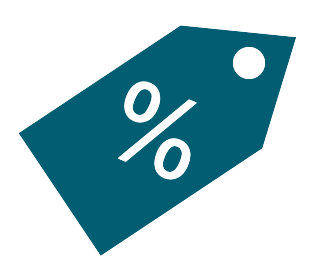Most people like getting a good deal when deciding to buy something, subscribe to a publication, join an organization or otherwise part with money. After all, it’s just plain fun saving 20%, 30% or more, especially if you were prepared to pay the full price initially. Getting a deal just makes you feel lucky and like a smart consumer!
When a member saves a little money at the time they join, they might also brag about that deal they bagged. They’ll tell a friend, and that friend tells a few friends—pretty soon there’s a mini network of people getting in on the deal. It’s a beautiful thing, not only for those who were lucky enough to save some money but ALSO for the organization they joined. Why? Because it can be a great long term proposition to bring in MORE members at a slightly lower price than fewer members at full price.
This is generally true for all continuity relationships, and frankly, we’re puzzled. There are still many organizations who are resistant to offering introductory discounts for a variety of reasons.
WHY FIRST-YEAR DISCOUNTING WORKS TO BUILD LONG-TERM RELATIONSHIPS
You are a continuity organization for a reason. You’ve found an interest area and specialized in developing your brand and your products into something of value. And the result is, people are willing and eager to pay (and renew) to be a part of it.
“If you build it they will come!”
If you can get one person to say “yes”, you can certainly get one hundred more, right? Let’s start with that as our baseline and do a very simplistic two-year example of what the revenue might look like using membership dues as our case study:
1st year: 100 new members join x $70 first-year dues = $7,000 in dues
2nd year: Of those 100 new members, if 75% renew at the $70 dues rate = $5,250 in dues
Total dues over 2 years = $12,250
Now imagine: You offer a discount of 20% off the first-year dues ($56 instead of $70). And because everyone loves a deal, you get 20% MORE prospects who become members.
With these new assumptions, here’s a revised look at our simplistic example:
1st year: 120 new members join x $56 first-year dues = $6,720 in dues
2nd year: Of those 120 new members, if 73%* renew at the $70 dues rate = $6,132 in dues
Total dues over 2 years = $12,852
*Includes the assumption that a discounted first-year member will potentially renew at a slightly lower rate.
That’s a 5% increase in dues revenue over 2 years. Not too bad, and that’s only the increased revenue from dues.
There’s potentially MORE upside because you now have more new members in your pool to which you can sell OTHER products, services, and membership upgrades. Translate this into your own vernacular: members, donors, subscribers, supporters, “friends.”
Yet, in spite of most everyone enjoying the thrill of scoring a deal, and the potentially favorable economics of offering first-year discounts, some organizations are still hesitant.
THERE ARE REASONS TO FEAR FIRST-YEAR DISCOUNTS BUT ARE THEY ALL VALID?
Continuity organizations are understandably very proud of the community they’ve built and the products and services they provide to their constituents. That’s what makes a passion-driven affinity so powerful, right? You are creating an experience where lots of like-minded people can feel good together, about something they all love to do.
That good feeling comes from the camaraderie, advocacy, magazines, member cards, decals, discounts and other benefits they receive. It’s rewarding for the organization to know that people with this shared interest are actually willing to PAY something to join and be a part of the exclusive group.
“BUT WE DON’T WANT TO DEVALUE THE BRAND BY OFFERING IT AT A DISCOUNTED RATE.”
When you start suggesting a first-year discount, this is one of the fears often expressed. All those benefits have value and are presumably worth far more than what you’ve stated as their annual price.
But before you jump to the conclusion that giving a discount in the first year devalues your “product”, consider this:
You have an entire year to illustrate all the value they are getting in benefits and services at that great introductory first-year price. If your programs and services satisfy them in the first year, they’ll remember that when it comes time to renew. Paying for another year at full price will be well worth their investment. The key here is to MAKE SURE you prove that value to them. Make sure you effectively onboard the new customer and provide ongoing communication, services and engagement throughout that first year.
“WHAT IF THIS SPECIAL DISCOUNTED FIRST-YEAR PRICE GOES VIRAL? WILL THEY TELL A FRIEND? WILL THAT FRIEND TELL OTHERS?”
This can be a GOOD problem to have (it’s what we at MCA call a “probletunity”). Consider the favorable impact filling the funnel with MORE members (even at that lower first-year price) can have on your dues revenue in the long haul. Think 6%, 10%, maybe even 15% increases as real possibilities. And don’t forget about the other non-dues revenue opportunities that come with more members.
“ARE WE CONDITIONING OUR AUDIENCE MEMBERS TO ALWAYS LOOK FOR A DEAL? WHAT IF THEY GAME US AND LOOK FOR WAYS TO CONTINUALLY SIGN UP AS A FIRST-YEAR MEMBER JUST TO GET THE DEAL?”
Some organizations also have angst about opening Pandora’s box of discounting.
You can overcome this fear and mitigate the risk by putting some checks and balances in place. Clearly state in the terms and conditions at sign up that the discount is for first-year customers only. Put logic checks in place that identify existing members and stop them from renewing at the discounted rate. And make sure you have a plan in place for handling longer tenured members who might complain that they have to pay more at renewal than a first-year member. Show those full-paying members the same love (or more!) that you do the first-year members who joined at a discount through things like unique renewal onboarding messaging, free downloads, and special new content notifications.
In general, you’ll likely find that very few people actually try to cheat the system and game you for the discount repeatedly. Yes, there will always be some who find a way to sneak around the rules, but our experience shows this is not a widespread problem. And it doesn’t outweigh the potential upside from MORE members and the longer-term increased revenue.
START BY DIPPING YOUR TOE IN THE DISCOUNT WATERS THROUGH TESTING
A smart way to see how your prospects will react to first-year discounts is to start out small and test a few scenarios.
Split your prospect pool and offer two different discount amounts head-to-head against a full-price offer. Then you’ll know how much of an increase you get at each price point. And don’t forget the part about fully onboarding and engaging your new friends in that first year (regardless of whether they received a discount or not). You can never love a first-year customer too much. You’ll reap the rewards of better renewal rates when the time comes for them to pull out their checkbooks again.
Challenge yourself and your organization to look beyond the short-term fears about discounting and consider the potential longer-term financial gains through MORE people joining your exclusive group.

